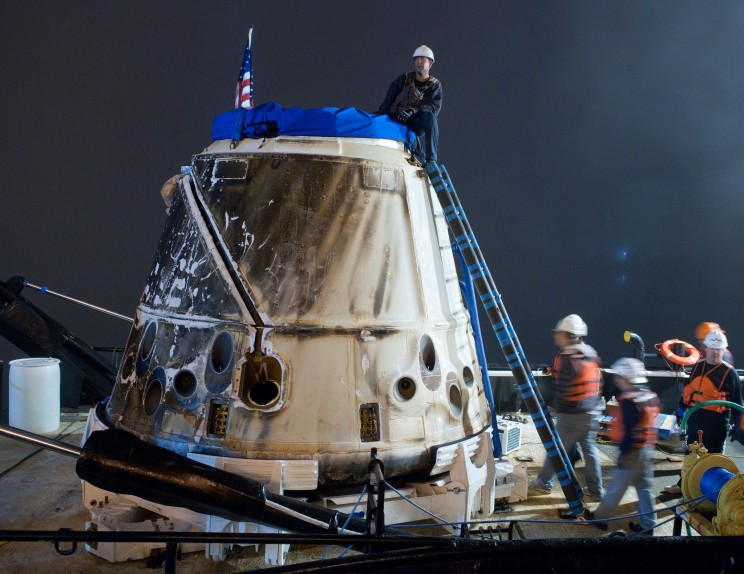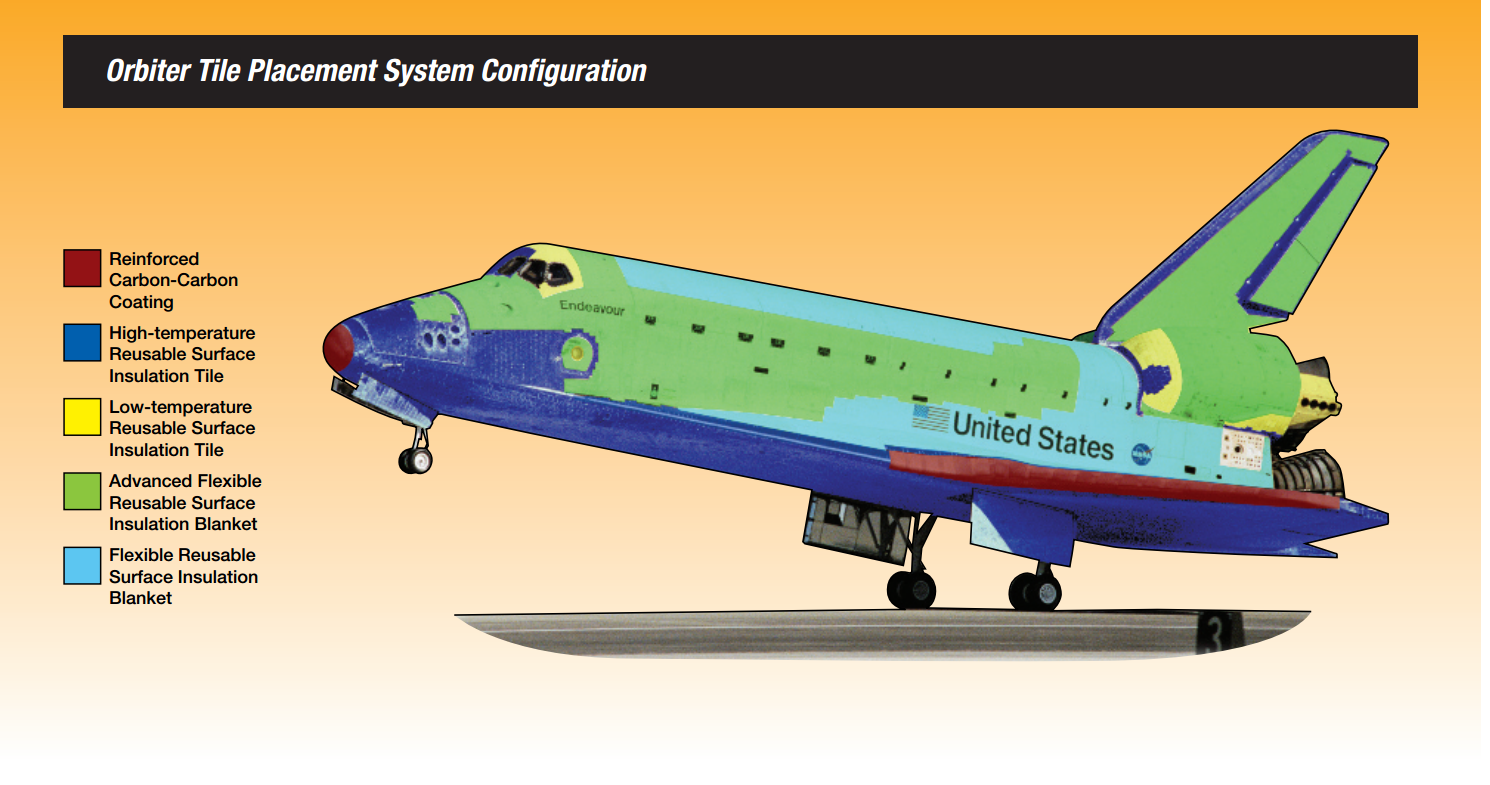 ..............................................................................................................................................................
..............................................................................................................................................................

Reentry Of Spaceships
What Keeps Spaceships from Burning Up During
Reentry?
Written by Maverick Baker
By Interesting Engineering
Thanks to engineers and scientists, it is now possible to
survive a fall while burning up at thousands of degrees during atmospheric
reentry.
Getting astronauts into space challenges engineers
with unprecedentedly difficult problems.
Though the spacecraft may have been proven during the
launch and duration of space exposure, it must still endure one of the most
demanding challenges of all: reentry.
At the end of a mission, spaceships re-enter the
Earth's atmosphere as they travel in excess of 30,000 km/h.
The tremendous speed of the reentry vehicle compresses
the air below into a hot ball of plasma which encircles the craft.
Getting the astronauts home safely will require
protecting them from the heat as it reaches thousands of degrees.
The dangers of reentry
Archeologists have long understood that asteroids burn
up as they fall through the atmosphere.
The fact instilled fear into scientists for decades as
they wondered about the possibility of engineering a vehicle strong enough to
withstand the perilous environment that reentry creates.
One of the greatest challenges imposed on aerospace
engineers is developing a thermal protective material which does not become
compromised, even at temperatures as high as 1,700-degrees Celsius.
A variety of Thermal Protection Systems (TPS) is
employed to prevent spaceships from preemptively burning. The heat shield is a
reentry vehicle's primary defense against the intense heat experienced as they
fall through the atmosphere.
Disaster strikes
One of the hard-learned lessons of reentry was during
Columbia's fatal flight on Feb. 1, 2003.
During the launch, a large piece of foam about the
size of a briefcase, tore loose and caused some damage to a heat shield panel
on the left wing.
The mission proceeded as usual until disaster struck
during reentry. Superheated plasma penetrated the compromised wing and quickly
burnt its structure.
Unfortunately, the Columbia began an uncontrollable
tumble, causing it to disintegrate. Seven astronauts lost their lives that day.
However, the unfortunate accident would force NASA to
redesign the Space Shuttle. More than a decade later, NASA is implementing the
lessons learned on its new ship, Orion.
Previous technologies
Early manned spacecraft including Mercury, Gemini, and
Apollo, could not be maneuvered during reentry.
The space capsules had followed ballistic re-entry
trajectories before they plummeted into the ocean.
Large heat-shields constructed of phenolic epoxy
resins in a nickel-alloy honeycomb array protected the capsules during reentry.
The shields could withstand incredibly high heating rates, a dire necessity
among reentry vehicles.
The Apollo moon missions posed a great engineering
hurdle since the capsules, as they returned from the moon and enter the
atmosphere at more than 40,000 km/h.
The heat shield was able to ablate or burn the char
layer controllably to protect the underlying layers. Though the heat shield was
effective, there were some critical drawbacks.
The shields were heavy and were bound directly to the
vehicle. Moreover, they were not reusable.
Perhaps the most impressive thermal protection system
(TPS) belongs to that of the Space Shuttle orbiter. The Space Shuttle program
required an entirely redesigned heat shield.
With an incredibly long design life of 100 missions,
its insulation not only had to perform well but also needed to be reusable. Its
engineering success will provide the innovative technologies which will carry
into the next generation of space programs.
The Space Shuttle thermal protection system
In space, the Orbiter would circle the world every
90-minutes. The time from day to night would see temperature fluctuations of
-130 degrees Celsius to nearly 100-degrees Celsius, let alone the temperatures
of reentry.
Though there exist many materials which are durable
enough to withstand the forces of reentry, not many can withstand the heat.
During reentry of the Orbiter, its external surfaces reached extreme
temperatures of up to 1,648°C (3,000°F).
Despite the extreme heat experienced by the TPS, many
systems work together to maintain the Orbiter's outer skin at under 176°C
(350°F).
Although the external components may be able to
survive hundreds of degrees, the aluminum airframe can only withstand
temperatures of up to a maximum of 150°C.
Temperatures much beyond the threshold will cause the
frame to become soft and compromised as a result. The thermal protection
systems in place ensure the airframe does not exceed the thermal limit.
The materials used to keep the Orbiter cool
NASA's first operational orbiter, otherwise known as
the Columbia, was constructed from four primary materials.
The materials include reinforced carbon-carbon (RCC),
low- and high-temperature reusable surface insulation tiles (LRSI and HRSI,
respectively), and felt reusable surface insulation (FRSI) blankets.
Different parts of the aircraft experience different
temperatures and therefore require different materials.
The parts most exposed to heat, including the nose and
underside of the Orbiter, are made from the most thermally resistant materials.
The leading edges require an additionally reinforced
carbon-carbon coating on top of the high-temperature insulation tiles.
Other areas, including most of the fuselage, were
covered in advanced flexible and reusable insulation blankets.
All components which come into contact with the
outside are covered in high emissivity coatings to ensure the Shuttle reflects
off most of the thermal heat. Though, the difference in color plays a vital role
as well.
Black and white tiles, while similar in composition,
perform different tasks during reentry.
The white tiles on the upper surface of the material
retain a high thermal reflectivity (a tendency to absorb minimal heat). The
black tiles are instead optimized for maximum emissivity which allows them to
lose heat faster than white tiles.
How they work
The tiles which take much of the brute force during
reentry are made of silica aerogels. The material used on the underside of the
Orbiter (known as LI-900) is 94 percent by volume of air making it incredibly
light.
The tiles are specifically designed to withstand
thermal shock. An LI-900 is capable of being heated to 1200 degrees then take a
plunge into cold water without sustaining damage.
Though, optimizing the tiles with a low density and
high shock resistance lead to a compromise in its overall strength.
Areas of high stress require a more robust material; a
problem later solved by the material LI-2200. LI-2200 tiles are modified to
withstand more force. Though, the stronger tiles have their drawbacks as well.
An LI-2200 tile weighs 22 pounds per cubic foot bulk
density compared to the much lighter LI-900 with a density of just 9 pounds per
cubic foot.
Re-entering the atmosphere today
Though astronauts have not visited the moon in a
while, and though the space shuttle program has since been abandoned,
astronauts routinely visit the ISS to perform experiments and repairs.
Though the spaceships have changed, the technologies
which bring them back home retain the same principles.
Orion Spacecraft
NASA's current magnum opus is their revolutionary
Orion spacecraft.
NASA promises the spacecraft will take humans farther
than ever before, including Mars. Although, the new spacecraft required a total
overhaul of its reentry systems.
While the Space Shuttle has remarkable TPS, engineers
have largely abandoned the idea of reusable thermal shields in favor of cheap,
easily manufactured single-use tiles.
The Orion capsule will not glide in as the Space
Shuttle once did. Instead, parachutes are used to ensure a safe return to
Earth. Orion's crew module is designed to reenter at speeds of more than 40,000
km/h.
How the Orion survives reentry
The large surface area of the bottom of the capsule
works to take the blunt of the force. Like the Apollo reentry vehicles, Orion's
heat shield is engineered to ablate (controllable burn).
The shield is aerodynamic enough to maintain a stable
flight path, yet blunt enough to slow the descent to a speed of just 500 km/h.
How to Land A Space Shuttle
After achieving a reasonable rate, several small
parachutes just over 2 meters in diameter slow the aircraft by only 30
km/h.
From there, a series of large parachutes with
diameters of 7-metres are deployed to slow the capsule to 200 km/h just
3-kilometers above the surface of the Earth.
Finally, three massive main parachutes with a diameter
of 35 meters each slow the rate of descent to a survivable speed. Though the
landing is not pretty.
However, it is through the hard daunting work
astronauts perform today that will advance humanity to make the next giant
leap.
Soon, missions will take humans far beyond the reach
of the Earth to explore otherworldly planets.
Founded on the core mission of connecting
likeminded engineers around the globe, Interesting Engineering is now a
leading community with more than 15 million+ minds. Every day we share a new
idea, a new thought, an upcoming technology OR an engineering breakthrough that
will change the way you think about technology and engineering in today’s world
and in the near future. Whether it’s a device that can charge your mobile in
seconds or it’s the latest model of Boeing that has launched moments ago, we
will bring everything up on your screen to view, to share and to grant you the
power to comment. We believe that sharing information is the only way that can
enrich and empower humans on this earth and we follow this as our core mission
and responsibility. If you have got something that could entice the world, then
Interesting Engineering is a perfect platform to show off your work to the
outside world.










No comments:
Post a Comment